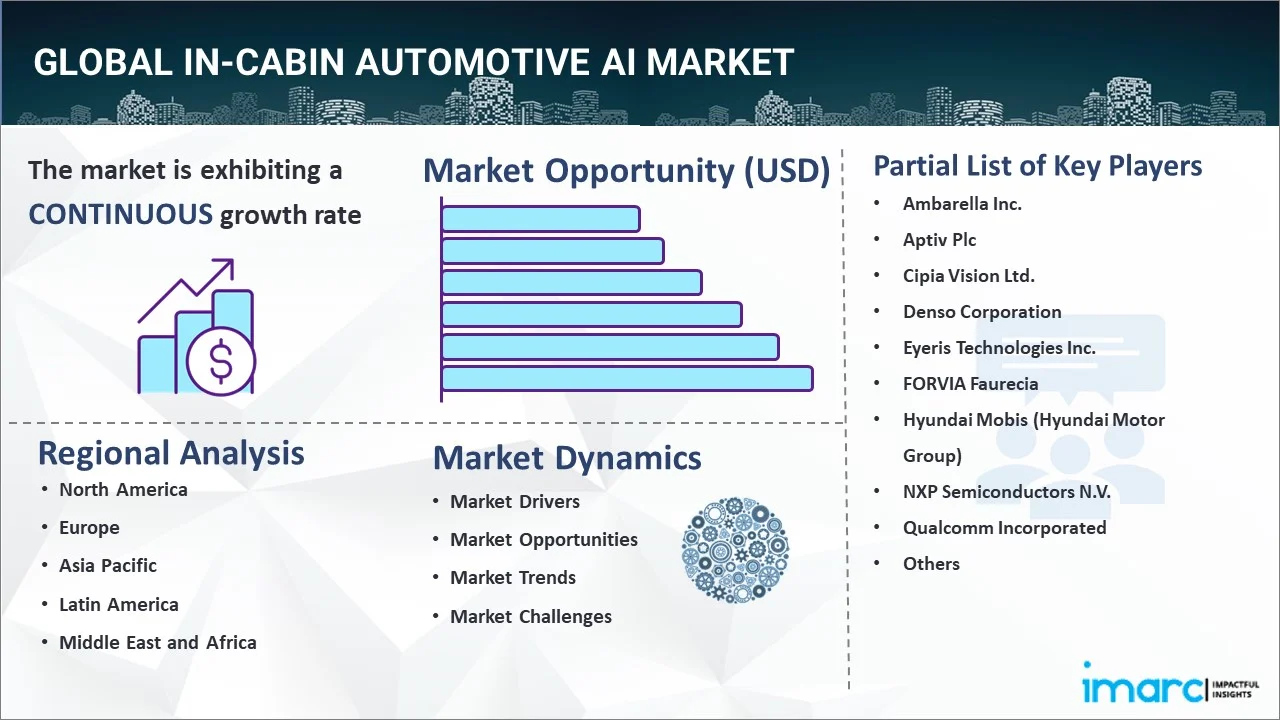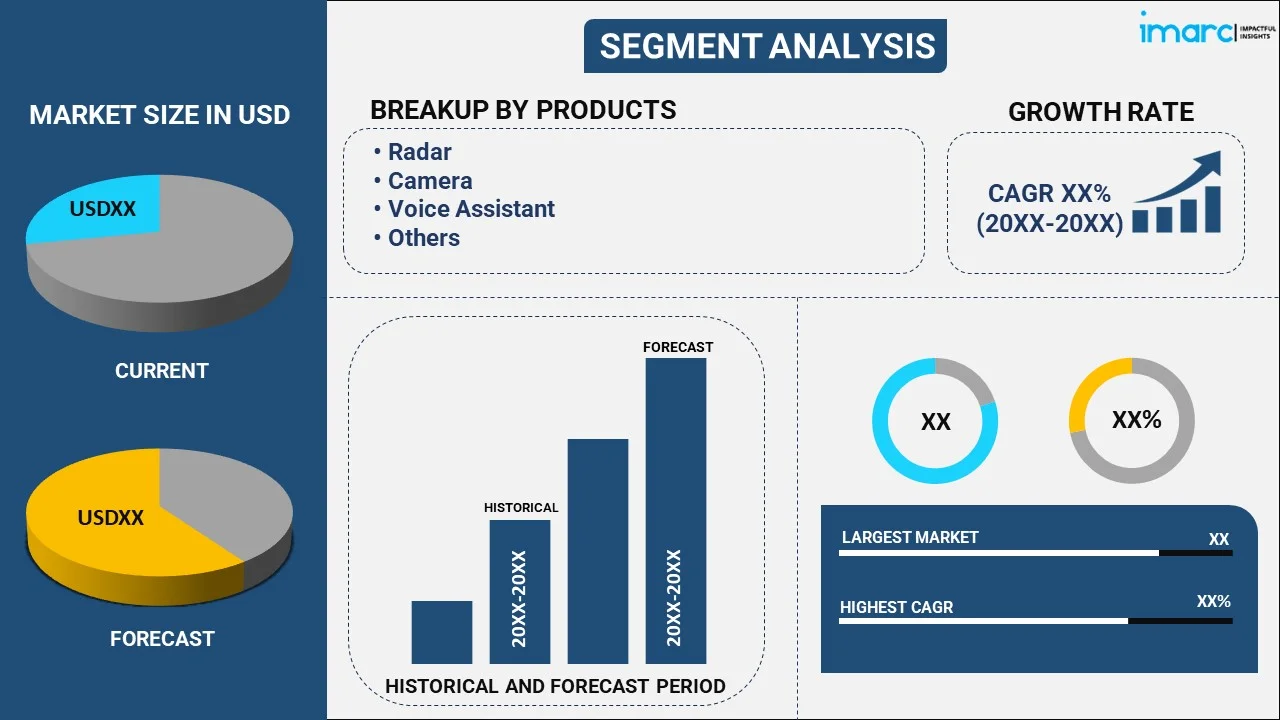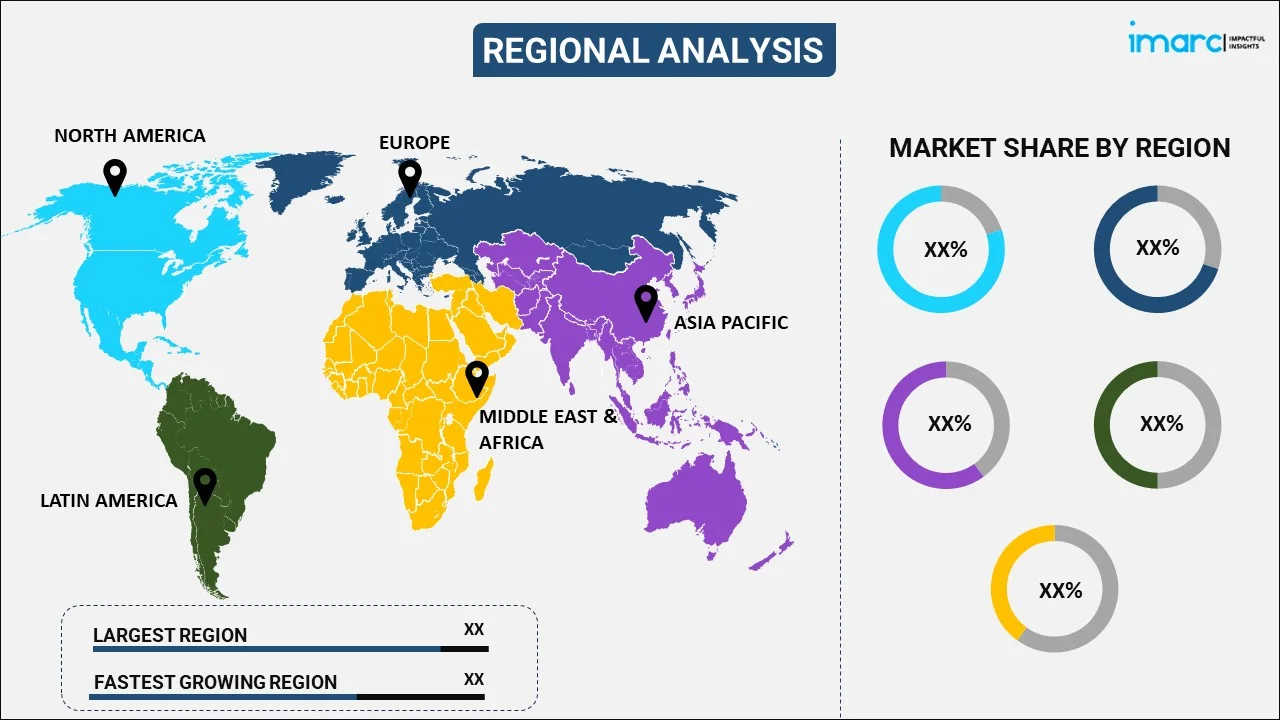
In-Cabin Automotive AI Market Report by Product (Radar, Camera, Voice Assistant, Smart Sensor), Application (Occupant Monitoring System, Driver Monitoring System, Conversation Assistance, Smart HVAC), and Region 2025-2033
In-Cabin Automotive AI Market Size, Industry Trends & Growth Forecast:
The global in-cabin automotive AI market size reached USD 177.0 Million in 2024. Looking forward, IMARC Group expects the market to reach USD 3,355.9 Million by 2033, exhibiting a growth rate (CAGR) of 36.74% during 2025-2033. The increasing demand for advanced driver assistance systems and autonomous driving technologies, growing demand for personalized driving experiences, and increasing adoption of electric vehicles represent some of the key factors driving the market. At present, Europe holds the largest share of the market due to the growing consumer demand for enhanced vehicle safety, personalized driving experiences, and advanced driver-assistance systems (ADAS), alongside regulations for road safety and emission reductions.
|
Report Attribute
|
Key Statistics
|
|---|---|
|
Base Year
|
2024
|
|
Forecast Years
|
2025-2033
|
|
Historical Years
|
2019-2024
|
|
Market Size in 2024
|
USD 177.0 Million |
|
Market Forecast in 2033
|
USD 3,355.9 Million |
| Market Growth Rate 2025-2033 | 36.74% |
In-cabin automotive AI refers to the use of artificial intelligence (AI) and machine learning (ML) technologies in vehicles to improve the driving experience and enhance safety. This technology can be used to analyze data from different sources, including sensors, cameras, and microphones, to provide insights into the driver's behavior, as well as the surrounding environment. In-cabin automotive AI can be used for numerous purposes, such as driver monitoring, facial recognition, voice recognition, and natural language processing. It can also be used to analyze data from vehicle sensors to detect potential safety hazards, such as lane departures, pedestrian detection, and collision avoidance. One of the key benefits of in-cabin automotive AI is its ability to adapt to individual driver behavior and preferences. In recent years, in-cabin automotive AI has gained traction as it has the potential to significantly improve the driving experience and enhance safety for both drivers and passengers.

In-Cabin Automotive AI Market Trends:
One of the primary factors driving the market is the increasing demand for advanced driver assistance systems (ADAS) and autonomous driving technologies, which rely on AI and ML to analyze data from a variety of sensors and make real-time decisions based on this data. In-cabin AI can enhance these technologies by providing additional data on driver behavior and the surrounding environment, improving safety and reducing the risk of accidents. Additionally, the growing demand for personalized driving experiences is contributing to the in-cabin automotive AI market growth. In-cabin AI can be used to learn a driver's preferences for seat position, climate control, and entertainment, and automatically adjust these settings based on the driver's behavior and environment. This improves the driving experience and also helps reduce driver fatigue and increase safety on long journeys. Other than this, the increasing adoption of electric vehicles (EVs) is creating new opportunities for in-cabin AI technologies. EVs require more sophisticated thermal management systems to maintain comfortable temperatures in the cabin, and AI can be used to optimize these systems based on driver behavior and weather conditions. In-cabin AI can also be used to monitor the battery and optimize charging behavior, improve range, and reduce the risk of battery damage. Moreover, the rise of connected cars and the Internet of Things (IoT) is escalating the demand for in-cabin AI technologies as they can be integrated with other IoT devices, such as smart home systems and wearables, to provide a seamless driving experience that is connected to the driver's broader digital life.
In-Cabin Automotive AI Market Segmentation:
IMARC Group provides an analysis of the key trends in each segment of the global in-cabin automotive AI market, along with forecasts at the global, regional, and country levels from 2025-2033. Our report has categorized the market based on the product and application.
Product Insights:

- Radar
- Camera
- Voice Assistant
- Smart Sensor
Camera accounts for the majority of the market share
The report has provided a detailed breakup and analysis of the in-cabin automotive AI market based on the product. This includes radar, camera, voice assistant, and smart sensor. According to the report, camera represented the largest segment.
Cameras dominate the market due to their critical role in monitoring driver behavior, ensuring safety, and enabling personalized passenger experiences. Equipped with advanced AI, cameras can detect driver drowsiness, distraction, and identity, enhancing driver assistance systems and compliance with safety regulations. In line with this, the integration of facial recognition, emotion detection, and gesture control functionalities makes cameras essential for delivering tailored in-cabin experiences. Moreover, this multifunctional capability and the increasing demand for safety-focused technology are expected to drive the in-cabin automotive AI market demand further across the globe.
Application Insights:
- Occupant Monitoring System
- Driver Monitoring System
- Conversation Assistance
- Smart HVAC
Driver monitoring system holds the largest share of the industry
A detailed breakup and analysis of the in-cabin automotive AI market based on the application has also been provided in the report. This includes occupant monitoring system, driver monitoring system, conversation assistance, and smart HVAC. According to the report, driver monitoring system accounted for the largest market share.
Driver monitoring systems represent the largest application segment in the market because of their essential role in enhancing road safety, meeting regulatory standards, and reducing accidents. These systems use AI to track driver alertness, detect fatigue, and monitor distractions, which are crucial for preventing incidents caused by inattention. The growing mandates in regions like Europe and the United States for improved driver safety, combined with the widespread adoption of autonomous and semi-autonomous vehicles, drive the demand for these advanced monitoring systems.
Regional Insights:

- North America
- United States
- Canada
- Europe
- Germany
- France
- United Kingdom
- Italy
- Spain
- Russia
- Others
- Asia Pacific
- China
- Japan
- India
- South Korea
- Australia
- Indonesia
- Others
- Latin America
- Brazil
- Mexico
- Others
- Middle East and Africa
Europe leads the market, accounting for the largest in-cabin automotive AI market share
The report has also provided a comprehensive analysis of all the major regional markets, which include North America (the United States and Canada); Europe (Germany, France, the United Kingdom, Italy, Spain, Russia, and others); Asia Pacific (China, Japan, India, South Korea, Australia, Indonesia, and others); Latin America (Brazil, Mexico, and others); and the Middle East and Africa. According to the report Europe was the largest market for in-cabin automotive AI.
The market in Europe is driven by stringent safety regulations, an increased demand for enhanced driving experiences, and the widespread adoption of autonomous and semi-autonomous vehicles. The growing focus on road safety has fueled the demand for driver monitoring systems, while consumer interest in advanced features like gesture control and personalized in-cabin experiences further accelerates AI integration. Additionally, advancements in sensor technologies and partnerships between automakers and tech firms are fostering innovation in the market across Europe.
Top In-Cabin Automotive AI Companies:
The report has also provided a comprehensive analysis of the competitive landscape in the global in-cabin automotive AI market. Detailed profiles of all major companies have also been provided. Some of the companies covered include:
- Ambarella Inc.
- Aptiv Plc
- Cipia Vision Ltd.
- Denso Corporation
- Eyeris Technologies Inc.
- FORVIA Faurecia
- Hyundai Mobis (Hyundai Motor Group)
- NXP Semiconductors N.V.
- Qualcomm Incorporated
- Renesas Electronics Corporation
- Robert Bosch GmbH (Robert Bosch Stiftung GmbH)
- Seeing Machines
- Valeo
- Visteon Corporation
- ZF Friedrichshafen AG
Kindly note that this only represents a partial list of companies, and the complete list has been provided in the report.
In-Cabin Automotive AI Market Report Coverage:
| Report Features | Details |
|---|---|
| Base Year of the Analysis | 2024 |
| Historical Period | 2019-2024 |
| Forecast Period | 2025-2033 |
| Units | Million USD |
| Products Covered | Radar, Camera, Voice Assistant, Smart Sensor |
| Applications Covered | Occupant Monitoring System, Driver Monitoring System, Conversation Assistance, Smart HVAC |
| Regions Covered | Asia Pacific, Europe, North America, Latin America, Middle East and Africa |
| Countries Covered | United States, Canada, Germany, France, United Kingdom, Italy, Spain, Russia, China, Japan, India, South Korea, Australia, Indonesia, Brazil, Mexico |
| Companies Covered | Ambarella Inc., Aptiv Plc, Cipia Vision Ltd., Denso Corporation, Eyeris Technologies Inc., FORVIA Faurecia, Hyundai Mobis (Hyundai Motor Group), NXP Semiconductors N.V., Qualcomm Incorporated, Renesas Electronics Corporation, Robert Bosch GmbH (Robert Bosch Stiftung GmbH), Seeing Machines, Valeo, Visteon Corporation, ZF Friedrichshafen AG, etc. |
| Customization Scope | 10% Free Customization |
| Post-Sale Analyst Support | 10-12 Weeks |
| Delivery Format | PDF and Excel through Email (We can also provide the editable version of the report in PPT/Word format on special request) |
Key Questions Answered in This Report:
- How has the global in-cabin automotive AI market performed so far, and how will it perform in the coming years?
- What are the drivers, restraints, and opportunities in the global in-cabin automotive AI market?
- What is the impact of each driver, restraint, and opportunity on the global in-cabin automotive AI market?
- What are the key regional markets?
- Which countries represent the most attractive in-cabin automotive AI market?
- What is the breakup of the market based on the product?
- Which is the most attractive product in the in-cabin automotive AI market?
- What is the breakup of the market based on the application?
- Which is the most attractive application in the in-cabin automotive AI market?
- What is the competitive structure of the global in-cabin automotive AI market?
- Who are the key players/companies in the in-cabin automotive AI market?
Key Benefits for Stakeholders:
- IMARC’s report offers a comprehensive quantitative analysis of various market segments, historical and current market trends, market forecasts, and dynamics of the in-cabin automotive AI market from 2019-2033.
- The research study provides the latest information on the market drivers, challenges, and opportunities in the global in-cabin automotive AI market.
- The study maps the leading, as well as the fastest-growing, regional markets. It further enables stakeholders to identify the key country-level markets within each region.
- Porter's five forces analysis assist stakeholders in assessing the impact of new entrants, competitive rivalry, supplier power, buyer power, and the threat of substitution. It helps stakeholders to analyze the level of competition within the in-cabin automotive AI industry and its attractiveness.
- Competitive landscape allows stakeholders to understand their competitive environment and provides an insight into the current positions of key players in the market.
Need more help?
- Speak to our experienced analysts for insights on the current market scenarios.
- Include additional segments and countries to customize the report as per your requirement.
- Gain an unparalleled competitive advantage in your domain by understanding how to utilize the report and positively impacting your operations and revenue.
- For further assistance, please connect with our analysts.
 Inquire Before Buying
Inquire Before Buying
 Speak to an Analyst
Speak to an Analyst
 Request Brochure
Request Brochure
 Request Customization
Request Customization




.webp)




.webp)












